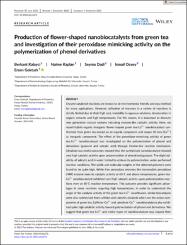| dc.contributor.author | Kalayci, Berkant | |
| dc.contributor.author | Kaplan, Naime | |
| dc.contributor.author | Dadi, Seyma | |
| dc.contributor.author | Ocsoy, Ismail | |
| dc.contributor.author | Gokturk, Ersen | |
| dc.date.accessioned | 2024-02-19T07:00:51Z | |
| dc.date.available | 2024-02-19T07:00:51Z | |
| dc.date.issued | 2024 | en_US |
| dc.identifier.issn | 1042-7147 | |
| dc.identifier.issn | 1099-1581 | |
| dc.identifier.other | WOS:001123515600001 | |
| dc.identifier.uri | https://doi.org/10.1002/pat.6272 | |
| dc.identifier.uri | https://hdl.handle.net/20.500.12573/1948 | |
| dc.description.abstract | Enzyme catalyzed reactions are known to be environmental friendly and easy method for many applications. However, utilization of enzymes in a variety of reactions is strictly limited due to their high cost, instability in aqueous solutions, denaturation in organic solvents and high temperatures. For this reason, it is important to discover new generation catalyst systems indicating enzyme-like catalytic activity. Here, we report hybrid organic-inorganic flower-shaped green tea-Cu2+ nanobiocatalyst synthesized from green tea extract as an organic component and copper (II) ions (Cu2+) as inorganic component. The effect of the peroxidase-mimicking activity of green tea-Cu2+ nanobiocatalyst was investigated on the polymerization of phenol and derivatives (guaiacol and salicylic acid) through Fenton-like reaction mechanism. Obtained successful outcomes showed that the synthesized nanobiocatalyst showed very high catalytic activity upon polymerization of phenol and guaiacol. The slight solubility of salicylic acid in water limited to achieve its polymerization under-performed reaction conditions. The yields and molecular weights of the obtained polymers were found to be quite high. While free peroxidase enzymes like horseradish peroxidase (HRP) enzyme loses its catalytic activity at 60 degrees C and above temperatures, green tea-Cu2+ nanobiocatalyst exhibited very high catalytic activity upon polymerization reactions even at 60 degrees C reaction temperature. This outcome provides significant advantages in some reactions requiring high temperatures. In order to understand the origin of the catalytic activity of the green tea-Cu2+ nanoflowers, similar biocatalysts were also synthesized from caffeine and catechin alkaloids which are the active components of green tea. Caffeine-Cu2+ and catechine-Cu2+ nanobiocatalysts also exhibited quite high catalytic activity toward polymerization of phenol and derivatives. We suggest that green tea-Cu2+ and similar types of nanobiocatalysts may expand their utilization in polymer chemistry as promising catalytic agents for radicalic polymerizations. | en_US |
| dc.description.sponsorship | This work was supported by Hatay Mustafa Kemal University
Coordinatorship of Scientific Research Projects (project # 20.M.048). | en_US |
| dc.language.iso | eng | en_US |
| dc.publisher | WILEY Online Library | en_US |
| dc.relation.isversionof | 10.1002/pat.6272 | en_US |
| dc.rights | info:eu-repo/semantics/openAccess | en_US |
| dc.subject | enzymatic polymerization | en_US |
| dc.subject | green tea extract | en_US |
| dc.subject | organic–inorganic hybrid nanoflowers | en_US |
| dc.subject | peroxidase | en_US |
| dc.subject | phenol derivatives | en_US |
| dc.title | Production of flower-shaped nanobiocatalysts from green tea and investigation of their peroxidase mimicking activity on the polymerization of phenol derivatives | en_US |
| dc.type | article | en_US |
| dc.contributor.department | AGÜ, Mühendislik Fakültesi, Malzeme Bilimi ve Nanoteknoloji Mühendisliği Bölümü | en_US |
| dc.contributor.authorID | 0000-0001-6280-3966 | en_US |
| dc.contributor.institutionauthor | Dadi, Seyma | |
| dc.identifier.volume | 35 | en_US |
| dc.identifier.issue | 1 | en_US |
| dc.identifier.startpage | 1 | en_US |
| dc.identifier.endpage | 11 | en_US |
| dc.relation.journal | POLYMERS FOR ADVANCED TECHNOLOGIES | en_US |
| dc.relation.publicationcategory | Makale - Uluslararası Hakemli Dergi - Kurum Öğretim Elemanı | en_US |


















